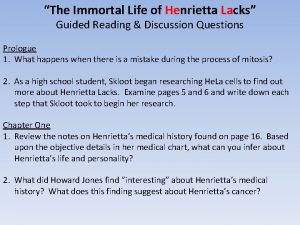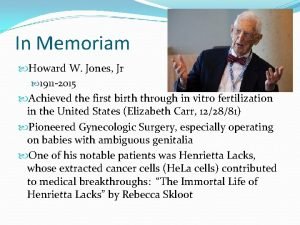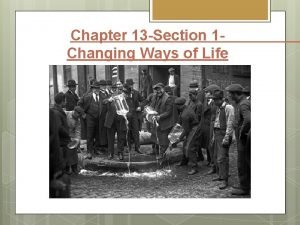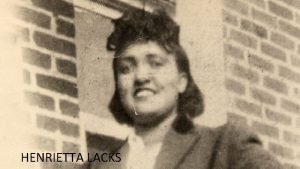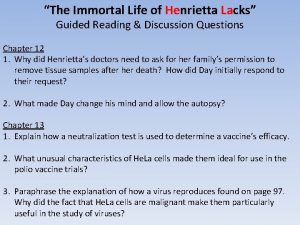The Immortal Life of Henrietta Lacks Guided Reading






- Slides: 6

“The Immortal Life of Henrietta Lacks” Guided Reading & Discussion Questions Prologue 1. What happens when there is a mistake during the process of mitosis? 2. As a high school student, Skloot began researching He. La cells to find out more about Henrietta Lacks. Examine pages 5 and 6 and write down each step that Skloot took to begin her research. Chapter One 1. Review the notes on Henrietta’s medical history found on page 16. Based upon the objective details in her medical chart, what can you infer about Henrietta’s life and personality? 2. What did Howard Jones find “interesting” about Henrietta’s medical history? What does this finding suggest about Henrietta’s cancer?

Chapter 2 1. Skloot uses vivid imagery and details to describe Henrietta’s childhood in Clover. Locate a passage that you found particularly effective or memorable, and explain why you selected it. 2. Compare the medical terms describing Elsie’s condition with the terms used by Henrietta’s friends and family. What are the connotations of the two sets of terms?

Chapter 3 1. How are different types of cancer categorized? 2. How did doctors justify using patients in public hospital wards as medical research subjects without obtaining their consent or offering them financial compensation? Do you agree or disagree with their reasoning? Explain your answer. 3. Explain what an immortal cell line is. 4. Do you think Henrietta would have given explicit consent to have a tissue sample used in medical research if she had been asked? Do you think she would have understood what was being asked of her? Explain your answers.

Chapter 4 1. Summarize the main obstacles Gey and his assistants faced in their effort to grow cells. 2. What happened to the He. La cells that Mary cultured? 3. Gey chose to give away samples of He. La to his colleagues almost immediately. Do you think this was a good decision? Explain your answer. Chapter 5 1. What important information did Henrietta’s doctor fail to give her before starting her cancer treatment? How did she react when this information was eventually shared with her? Chapter 6 1. Paraphrase the information on page 50 describing the Tuskegee Syphilis Study. 2. What do the Tuskegee Syphilis Study and the Mississippi Appendectomies suggest about the history of African Americans and medicine?

Chapter 7 1. What did He. La cells allow scientists to do for the first time? 2. Give an example of propaganda that was used to fuel the public’s fear and distrust of tissue culture. 3. What details suggest that Carrel’s claims about the immortal cell line were not scientifically sound? Chapter 8 1. In your own words, explain the paradox “benevolent deception. ” 2. What does the use of the term “a miserable specimen” by Henrietta’s doctors reveal about their attitude toward her? 3. Most accounts suggest that Henrietta never met George Gey. If Gey did speak to Henrietta just before she died, do you think she would have understood what immortal cells were? Explain your answer.

Chapter 9 1. Who is Courtney “Mama” Speed and how is she connected to Henrietta Lacks? 2. What does Rebecca Skloot realize after watching the BBC documentary about He. La? Chapter 10 1. What illness did Cootie have a child? 2. Cootie seems to know and understand a little about He. La cells, but he believes that Henrietta’s spirit is still present in her cells. What does Cootie think about the reason that He. La cells were used to develop a polio vaccine? Chapter 11 1. Describe the progression of Henrietta’s cancer in the eight months between her diagnosis and her death.

